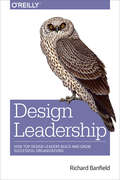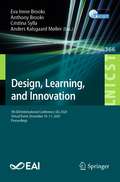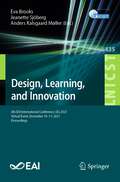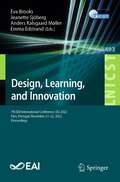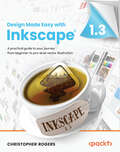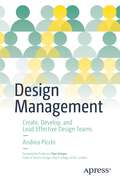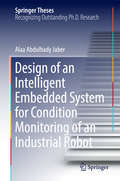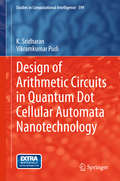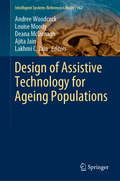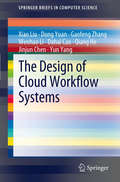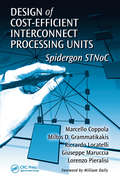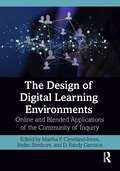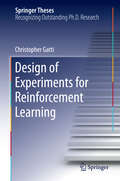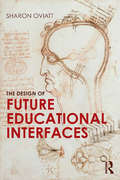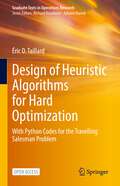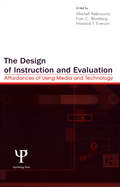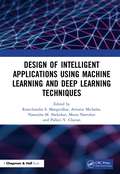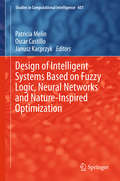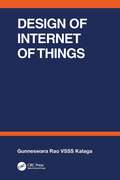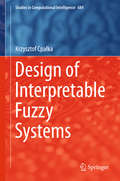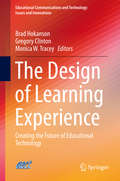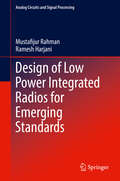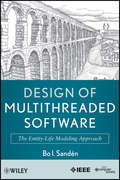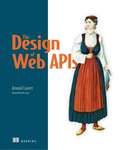- Table View
- List View
Design Leadership
by Richard BanfieldWhat does it take to be the leader of a design firm or group? We often assume they have all the answers, but in this rapidly evolving industry they're forced to find their way like the rest of us. So how do good design leaders manage? If you lead a design group, or want to understand the people who do, this insightful book explores behind-the-scenes strategies and tactics from leaders of top design companies throughout North America.Based on scores of interviews he conducted over a two-year period--from small companies to massive corporations like ESPN--author Richard Banfield covers a wide range of topics, including:How design leaders create a healthy company cultureInnovative ways for attracting and nurturing talentCreating productive workspaces, and handling remote employeesStaying on top of demands while making time for themselvesConsistent patterns among vastly different leadership stylesTechniques and approaches for keeping the work pipeline fullMaking strategic and tactical plans for the futureMistakes that design leaders made--and how they bounced back
Design, Learning, and Innovation: 5th EAI International Conference, DLI 2020, Virtual Event, December 10-11, 2020, Proceedings (Lecture Notes of the Institute for Computer Sciences, Social Informatics and Telecommunications Engineering #366)
by Eva Irene Brooks Anthony Brooks Cristina Sylla Anders Kalsgaard MøllerThis book constitutes the refereed post-conference proceedings the 5th EAI International Conference on DLI 2020, Design, Leaning and Innovation, which took place in December 2020. Due to COVID-19 pandemic the conference was held virtually. The 14 revised full papers presented were carefully selected from 40 submissions and are organized in four thematic sessions on: digital technologies and learning; designing for innovation; digital games, gamification and robots; designs for innovative learning.
Design, Learning, and Innovation: 6th EAI International Conference, DLI 2021, Virtual Event, December 10-11, 2021, Proceedings (Lecture Notes of the Institute for Computer Sciences, Social Informatics and Telecommunications Engineering #435)
by Eva Brooks Jeanette Sjöberg Anders Kalsgaard MøllerThis book constitutes the refereed post-conference proceedings the 6th EAI International Conference on Design, Leaning and Innovation, DLI 2021, which took place in December 2021. Due to COVID-19 pandemic the conference was held virtually. The theme for DLI 2021 was “Shifting boundaries to discover novel ways and emerging technologies to realise human needs, ideas, and desires” targeting a conceptualisation of the effects and impact of digital technologies for, in an inclusive and playful way, fostering human beings to realising their needs, ideas and desires. The 17 revised full papers presented were carefully selected from 36 submissions and are organized in four thematic sessions on: digital technologies, design and learning; tools and models; artificial intelligence, virtual reality and augmented reality in learning; innovative designs and learning.
Design, Learning, and Innovation: 7th EAI International Conference, DLI 2022, Faro, Portugal, November 21-22, 2022, Proceedings (Lecture Notes of the Institute for Computer Sciences, Social Informatics and Telecommunications Engineering #493)
by Eva Brooks Jeanette Sjöberg Anders Kalsgaard Møller Emma EdstrandThis book constitutes the refereed post-conference proceedings the 7th International Conference on Design, Leaning and Innovation, DLI 2022, which took place in Faro, Portugal, in November 21-22, 2022. The 4 revised full papers and 2 short papers presented were carefully selected from 32 submissions on. They were organized in topical sections as follows: Digital Environments and Design Processes Fostering Learning and Interaction, Designs for Innovative Learning with Digital Technology, Digital Approaches Shaping Educational Practices.
Design Made Easy with Inkscape: A practical guide to your journey from beginner to pro-level vector illustration
by Christopher RogersDiscover quick and easy ways to make charts, diagrams, illustrations, and UX/UI mockups with end-to-end guidance using hands-on tutorials, tips, and tricksKey FeaturesGet up to speed with vector illustration in no timeExplore hotkey charts and tips, with best practices developed over ten years of using InkscapeLearn the fundamentals of vector illustration and efficiently leverage Inkscape's powerful toolsetBook DescriptionWith the power and versatility of the Inkscape software, making charts, diagrams, illustrations, and UI mockups with infinite resolution becomes enjoyable. If you're looking to get up to speed with vector illustration in no time, this comprehensive guide has got your back! Design Made Easy with Inkscape is easy to follow and teaches you everything you need to know to create graphics that you can use and reuse forever, for free! You'll benefit from the author's industry experience as you go over the basics of vector illustration, discovering tips and tricks for getting professional graphics done fast by leveraging Inkscape's powerful toolset. This book teaches by example, using a great variety of use cases from icons and logos to illustration, web design, and product design. You'll learn about hotkeys and take a best-practices approach developed over ten years of using Inkscape as a design tool in production. What's more, this book also includes links to free graphics resources that you can use in all your projects. Whether you're a new user or a professional, by the end of this book, you'll have full understanding of how to use Inkscape and its myriad of excellent features to make stunning graphics for your projects.What you will learnUnderstand the benefits of vector illustration and the reasons behind choosing Inkscape over other non-free alternativesNavigate the Inkscape setup and workspace to make effective use of the softwareExplore the wide range of tools from Inkscape to create amazing and infinitely scalable graphics quicklyUse real-world scenarios and practice lessons to learn how to create by exampleDiscover tips and tricks to make Inkscape an extension of your creativityConvert photos to vector art and practice with professional design examples as you work with layers, shading, coloring and much moreWho this book is forThis book is for aspiring designers, developers, and anyone who wants to leverage the power of Inkscape for vector illustration. No prior knowledge of graphics applications or vector and raster graphics is required. This book simplifies Inkscape for dummies; all you need to know is how to use a mouse and keyboard.
Design Management: Create, Develop, and Lead Effective Design Teams
by Andrea PicchiDesigners are more in-demand than ever, and companies all over the world are creating new leadership roles to manage them. With only a few select institutions teaching effective design management skills, self-taught design managers are on the rise and resources are needed to guide them. This book will help you hone your leadership skills and magnify your team’s potential. Eager designers will learn the behavioral abilities required to lead and manage impactful and efficient teams using a systemic, context-agnostic, and therefore repeatable approach. While effective design management is vital in these times of complexity and fast change in organizations, the available literature on design management is insufficient, predominately informative, and unfortunately, not actionable. This book fills that gap by illuminating the soft skills you need to lead your team to success. You'll gain confidence about how to optimize meetings, run successful kickoffs, manage yourself, and how to best approach and frame your working environment. Whether you are a designer looking to lead, or a member of an organization looking for guidance on how to better incorporate design, this book belongs on your shelf. Design Management is here to assist you in the long haul.What You'll LearnComprehend the underlying social and psychological dynamics of leadership and managementCultivate the behavioral elements of a design managerUnderstand the building blocks of a design leaderEstablish your core practices and create a self-development programDevelop and project healthy and sustainable influenceBuild trust, create psychological safety, and fulfill the social needs of high-performing teamsCoach individuals and groups to unlock creativity and nurture creative collaborationOptimize in-person and remote design operations Who This Book Is ForEveryone who desires to expand and deepen their knowledge of design leadership and management, comprehending the social and psychological underpinning elements of this discipline. Aspiring or recently appointed design leaders and managers who necessitate a practical education in this field and individuals already in charge of a group who aspire to evolve their understanding to advance their career toward a Head of Design or Chief Design Officer role.
Design of an Intelligent Embedded System for Condition Monitoring of an Industrial Robot
by Alaa Abdulhady JaberThis thesis introduces a successfully designed and commissioned intelligent health monitoring system, specifically for use on any industrial robot, which is able to predict the onset of faults in the joints of the geared transmissions. However the developed embedded wireless condition monitoring system leads itself very well for applications on any power transmission equipment in which the loads and speeds are not constant, and access is restricted. As such this provides significant scope for future development. Three significant achievements are presented in this thesis. First, the development of a condition monitoring algorithm based on vibration analysis of an industrial robot for fault detection and diagnosis. The combined use of a statistical control chart with time-domain signal analysis for detecting a fault via an arm-mounted wireless processor system represents the first stage of fault detection. Second, the design and development of a sophisticated embedded microprocessor base station for online implementation of the intelligent condition monitoring algorithm, and third, the implementation of a discrete wavelet transform, using an artificial neural network, with statistical feature extraction for robot fault diagnosis in which the vibration signals are first decomposed into eight levels of wavelet coefficients.
Design of Arithmetic Circuits in Quantum Dot Cellular Automata Nanotechnology
by K. Sridharan Vikramkumar PudiThis research monograph focuses on the design of arithmetic circuits in Quantum Dot Cellular Automata (QCA). Using the fact that the 3-input majority gate is a primitive in QCA, the book sets out to discover hitherto unknown properties of majority logic in the context of arithmetic circuit designs. The pursuit for efficient adders in QCA takes two forms. One involves application of the new results in majority logic to existing adders. The second involves development of a custom adder for QCA technology. A QCA adder named as hybrid adder is proposed and it is shown that it outperforms existing multi-bit adders with respect to area and delay. The work is extended to the design of a low-complexity multiplier for signed numbers in QCA. Furthermore the book explores two aspects unique to QCA technology, namely thermal robustness and the role of interconnects. In addition, the book introduces the reader to QCA layout design and simulation using QCADesigner. Features & Benefits: This research-based book: ·Introduces the reader to Quantum Dot Cellular Automata, an emerging nanotechnology. ·Explores properties of majority logic. ·Demonstrates application of the properties to design efficient arithmetic circuits. ·Guides the reader towards layout design and simulation in QCADesigner.
Design of Assistive Technology for Ageing Populations (Intelligent Systems Reference Library #167)
by Andree Woodcock Louise Moody Deana McDonagh Ajita Jain Lakhmi C. JainThis book focuses on various aspects of research on aging, including in relation to assistive technology; dignity of aging; how technology can support a greater understanding of the experience of physically aging and cognitive changes; mobility issues associated with the elderly; and emerging technologies. The 80+ age group represents an expanding market, with an estimated worth of £21.4 billion a year. Everyone is affected by this shift in demographics – we are getting older and may become carers – and we need to prepare ourselves and adjust our surroundings for longer life. Products, services and environments have been changing in response to the changing population. Presenting international design research to demonstrate the thinking and ideas shaping design, this book is a valuable resource for designers; product developers; employers; gerontologists; and medical, health and service providers; as well as everyone interested in aging.
The Design of Cloud Workflow Systems
by Qiang He Dahai Cao Dong Yuan Wenhao Li Xiao Liu Yun Yang Gaofeng Zhang Jinjun ChenCloud computing is the latest market-oriented computing paradigm which brings software design and development into a new era characterized by "XaaS", i.e. everything as a service. Cloud workflows, as typical software applications in the cloud, are composed of a set of partially ordered cloud software services to achieve specific goals. However, due to the low QoS (quality of service) nature of the cloud environment, the design of workflow systems in the cloud becomes a challenging issue for the delivery of high quality cloud workflow applications. To address such an issue, this book presents a systematic investigation to the three critical aspects for the design of a cloud workflow system, viz. system architecture, system functionality and quality of service. Specifically, the system architecture for a cloud workflow system is designed based on the general four-layer cloud architecture, viz. application layer, platform layer, unified resources layer and fabric layer. The system functionality for a cloud workflow system is designed based on the general workflow reference model but with significant extensions to accommodate software services in the cloud. The support of QoS is critical for the quality of cloud workflow applications. This book presents a generic framework to facilitate a unified design and development process for software components that deliver lifecycle support for different QoS requirements. While the general QoS requirements for cloud workflow applications can have many dimensions, this book mainly focuses on three of the most important ones, viz. performance, reliability and security. In this book, the architecture, functionality and QoS management of our SwinDeW-C prototype cloud workflow system are demonstrated in detail as a case study to evaluate our generic design for cloud workflow systems. To conclude, this book offers a general overview of cloud workflow systems and provides comprehensive introductions to the design of the system architecture, system functionality and QoS management.
Design of Cost-Efficient Interconnect Processing Units: Spidergon STNoC (System-on-Chip Design and Technologies)
by Marcello Coppola Miltos D. Grammatikakis Riccardo Locatelli Giuseppe Maruccia Lorenzo PieralisiStreamlined Design Solutions Specifically for NoCTo solve critical network-on-chip (NoC) architecture and design problems related to structure, performance and modularity, engineers generally rely on guidance from the abundance of literature about better-understood system-level interconnection networks. However, on-chip networks present several distinct challenges that require novel and specialized solutions not found in the tried-and-true system-level techniques. A Balanced Analysis of NoC ArchitectureAs the first detailed description of the commercial Spidergon STNoC architecture, Design of Cost-Efficient Interconnect Processing Units: Spidergon STNoC examines the highly regarded, cost-cutting technology that is set to replace well-known shared bus architectures, such as STBus, for demanding multiprocessor system-on-chip (SoC) applications. Employing a balanced, well-organized structure, simple teaching methods, numerous illustrations, and easy-to-understand examples, the authors explain: how the SoC and NoC technology works why developers designed it the way they did the system-level design methodology and tools used to configure the Spidergon STNoC architecture differences in cost structure between NoCs and system-level networks From professionals in computer sciences, electrical engineering, and other related fields, to semiconductor vendors and investors – all readers will appreciate the encyclopedic treatment of background NoC information ranging from CMPs to the basics of interconnection networks. The text introduces innovative system-level design methodology and tools for efficient design space exploration and topology selection. It also provides a wealth of key theoretical and practical MPSoC and NoC topics, such as technological deep sub-micron effects, homogeneous and heterogeneous processor architectures, multicore SoC, interconnect processing units, generic NoC components, and embeddings of common communication patterns. An Arsenal of Practical Learning Tools at Your DisposalThe book features a complimentary CD-ROM for practical training on NoC modeling and design-space exploration. It incorporates the award-winning System C-based On-Chip Communication Network (OCCN) environment, the only open-source network modeling and simulation framework currently available. With its consistent, comprehensive overview of the state of the art – and future trends – of NoC design, this indispensible text can help readers harness the value within the vast and ever-changing world of network-on-chip technology.
The Design of Digital Learning Environments: Online and Blended Applications of the Community of Inquiry
by Cleveland-Innes, Martha F. Stefan Stenbom D. Randy GarrisonThe Design of Digital Learning Environments provides comprehensive guidelines for creating and delivering high-quality online and blended learning experiences in higher education. With increasing numbers of students engaged in partially or fully digital education, graduate students preparing for design, development, or faculty roles need fresh, practical applications of cutting-edge research and theory. This textbook uses the Community of Inquiry framework, an influential and invaluable pedagogical model focused on deep learning, to aid educators in forging meaningful, collaborative connections with students engaged in digitally supported multi-modal learning in colleges and universities, MOOCs, and lifelong learning initiatives. Across five parts, the book covers the basic structure, concepts, terminology, and history of the Community of Inquiry; principles for designing and delivering digital courses; design for specific course conditions; applications of learning activities guided by the framework; and current limitations and directions for further research.
Design of Experiments for Reinforcement Learning
by Christopher GattiThis thesis takes an empirical approach to understanding of the behavior and interactions between the two main components of reinforcement learning: the learning algorithm and the functional representation of learned knowledge. The author approaches these entities using design of experiments not commonly employed to study machine learning methods. The results outlined in this work provide insight as to what enables and what has an effect on successful reinforcement learning implementations so that this learning method can be applied to more challenging problems.
The Design of Future Educational Interfaces
by Sharon OviattThe Design of Future Educational Interfaces provides a new multidisciplinary synthesis of educational interface research. It explains how computer interfaces can be redesigned to better support our ability to produce ideas, think, and solve problems successfully in national priority areas such as science and mathematics. Based on first-hand research experience, the author offers a candid analysis of emerging technologies and their impact, highlighting communication interfaces that stimulate thought. The research results will surprise readers and challenge their assumptions about existing technology and its ability to support our performance. In spite of a rapid explosion of interest in educational technologies, there remains a poor understanding of what constitutes an effective educational interface for student cognition and learning. This book provides valuable insights into why recent large-scale evaluations of existing educational technologies have frequently not shown demonstrable improvements in student performance. The research presented here is grounded in cognitive science and experimental psychology, linguistic science and communications, cross-cultural cognition and language, computer science and human interface design, and the learning sciences and educational technology.
Design of Heuristic Algorithms for Hard Optimization: With Python Codes for the Travelling Salesman Problem (Graduate Texts in Operations Research)
by Éric D. TaillardThis open access book demonstrates all the steps required to design heuristic algorithms for difficult optimization. The classic problem of the travelling salesman is used as a common thread to illustrate all the techniques discussed. This problem is ideal for introducing readers to the subject because it is very intuitive and its solutions can be graphically represented. The book features a wealth of illustrations that allow the concepts to be understood at a glance. The book approaches the main metaheuristics from a new angle, deconstructing them into a few key concepts presented in separate chapters: construction, improvement, decomposition, randomization and learning methods. Each metaheuristic can then be presented in simplified form as a combination of these concepts. This approach avoids giving the impression that metaheuristics is a non-formal discipline, a kind of cloud sculpture. Moreover, it provides concrete applications of the travelling salesman problem, which illustrate in just a few lines of code how to design a new heuristic and remove all ambiguities left by a general framework. Two chapters reviewing the basics of combinatorial optimization and complexity theory make the book self-contained. As such, even readers with a very limited background in the field will be able to follow all the content.
The Design of Instruction and Evaluation: Affordances of Using Media and Technology
by Mitchell Rabinowitz Fran C. Blumberg Howard T. EversonThis book is about empirically tested knowledge and principles that inform the design of instructional and evaluation systems, and the use and promise of media and technology within such systems. Historically, psychology has informed the design of instructional and evaluation systems in different ways. A behavioral perspective emphasizes the role of the environment in determining behavior--a factor external to the learner. A cognitive perspective focuses on the role of cognitive processing and constraints in determining learning--factors that are internal to the learner. This volume presents the affordances approach--which addresses how the environment and the affordances within it interact with cognitive processes to determine learning. Insights into this interaction are presented. It is the book's contention that the affordance approach represents an advancement over the behavioral and cognitive perspectives; it is an evolution within the cognitive approach--not an alternative to it. The Design of Instruction and Evaluation: Affordances of Using Media and Technology is intended for education practitioners responsible for the implementation of media and technology in classrooms, for researchers and faculty, and for use as a text in courses on media and technology use in educational settings, instructional design, and psychology of learning.
Design of Intelligent Applications using Machine Learning and Deep Learning Techniques
by Ramchandra S. Mangrulkar Antonis Michalas Narendra M. Shekokar Meera Narvekar Pallavi V. ChavanMachine learning (ML) and deep learning (DL) algorithms are invaluable resources for Industry 4.0 and allied areas and are considered as the future of computing. A subfield called neural networks, to recognize and understand patterns in data, helps a machine carry out tasks in a manner similar to humans. The intelligent models developed using ML and DL are effectively designed and are fully investigated – bringing in practical applications in many fields such as health care, agriculture and security. These algorithms can only be successfully applied in the context of data computing and analysis. Today, ML and DL have created conditions for potential developments in detection and prediction. Apart from these domains, ML and DL are found useful in analysing the social behaviour of humans. With the advancements in the amount and type of data available for use, it became necessary to build a means to process the data and that is where deep neural networks prove their importance. These networks are capable of handling a large amount of data in such fields as finance and images. This book also exploits key applications in Industry 4.0 including: · Fundamental models, issues and challenges in ML and DL. · Comprehensive analyses and probabilistic approaches for ML and DL. · Various applications in healthcare predictions such as mental health, cancer, thyroid disease, lifestyle disease and cardiac arrhythmia. · Industry 4.0 applications such as facial recognition, feather classification, water stress prediction, deforestation control, tourism and social networking. · Security aspects of Industry 4.0 applications suggest remedial actions against possible attacks and prediction of associated risks. - Information is presented in an accessible way for students, researchers and scientists, business innovators and entrepreneurs, sustainable assessment and management professionals. This book equips readers with a knowledge of data analytics, ML and DL techniques for applications defined under the umbrella of Industry 4.0. This book offers comprehensive coverage, promising ideas and outstanding research contributions, supporting further development of ML and DL approaches by applying intelligence in various applications.
Design of Intelligent Systems Based on Fuzzy Logic, Neural Networks and Nature-Inspired Optimization
by Patricia Melin Oscar Castillo Janusz KacprzykThis book presents recent advances on the design of intelligent systems based on fuzzy logic, neural networks and nature-inspired optimization and their application in areas such as, intelligent control and robotics, pattern recognition, time series prediction and optimization of complex problems. The book is organized in eight main parts, which contain a group of papers around a similar subject. The first part consists of papers with the main theme of theoretical aspects of fuzzy logic, which basically consists of papers that propose new concepts and algorithms based on fuzzy systems. The second part contains papers with the main theme of neural networks theory, which are basically papers dealing with new concepts and algorithms in neural networks. The third part contains papers describing applications of neural networks in diverse areas, such as time series prediction and pattern recognition. The fourth part contains papers describing new nature-inspired optimization algorithms. The fifth part presents diverse applications of nature-inspired optimization algorithms. The sixth part contains papers describing new optimization algorithms. The seventh part contains papers describing applications of fuzzy logic in diverse areas, such as time series prediction and pattern recognition. Finally, the eighth part contains papers that present enhancements to meta-heuristics based on fuzzy logic techniques.
Design of Internet of Things
by Gunneswara VSSS Kalaga RaoThe text provides a comprehensive overview of the design aspects of the internet of things devices and covers the fundamentals of big data and data science. It explores various scenarios such as what are the middleware and frameworks available and how to build a stable, standards-based, and Secure internet of things device. It discusses important concepts including embedded programming techniques, machine-to-machine architecture, and the internet of things for smart city applications. It will serve as an ideal design book for professionals, senior undergraduate, and graduate students in the fields including electrical engineering, electronics and communication engineering, and computer engineering. The book- Covers applications and architecture needed to deliver solutions to end customers and readers. Discusses practical aspects of implementing the internet of things in diverse areas including manufacturing, and software development. Highlights big data concepts and embedded programming techniques. Presents technologies including machine to machine, integrated sensors, and radio-frequency identification. Introduces global system for mobile communication and precise details of standards based on internet of things architecture models. The book focuses on practical design aspects such as how to finalize a processor integrated circuit, which operating system to use, etc. in a single volume. It will serve as an ideal text for professionals, senior undergraduate, and graduate students in diverse engineering domains including electrical, electronics and communication, computer.
Design of Interpretable Fuzzy Systems (Studies in Computational Intelligence #684)
by Krzysztof CpałkaThis book shows that the term “interpretability” goes far beyond the concept of readability of a fuzzy set and fuzzy rules. It focuses on novel and precise operators of aggregation, inference, and defuzzification leading to flexible Mamdani-type and logical-type systems that can achieve the required accuracy using a less complex rule base. The individual chapters describe various aspects of interpretability, including appropriate selection of the structure of a fuzzy system, focusing on improving the interpretability of fuzzy systems designed using both gradient-learning and evolutionary algorithms. It also demonstrates how to eliminate various system components, such as inputs, rules and fuzzy sets, whose reduction does not adversely affect system accuracy. It illustrates the performance of the developed algorithms and methods with commonly used benchmarks. The book provides valuable tools for possible applications in many fields including expert systems, automatic control and robotics.
The Design of Learning Experience
by Brad Hokanson Gregory Clinton Monica W. TraceyThis book delves into two divergent, yet parallel themes; first is an examination of how educators can design the experiences of learning, with a focus on the learner and the end results of education; and second, how educators learn to design educational products, processes and experiences. The book seeks to understand how to design how learning occurs, both in the instructional design studio and as learning occurs throughout the world. This will change the area's semantics; at a deeper level, it will change its orientation from instructors and information to learners; and it will change how educators take advantage of new and old technologies. This book is the result of a research symposium sponsored by the Association for Educational Communications and Technology [AECT].
Design of Low Power Integrated Radios for Emerging Standards (Analog Circuits and Signal Processing)
by Mustafijur Rahman Ramesh HarjaniThis book describes novel and disruptive architecture and circuit design techniques, toward the realization of low-power, standard-compliant radio architectures and silicon implementation of the circuits required for a variety of leading-edge applications. Readers will gain an understanding of the circuit level challenges that exist for low power radios, compatible with the IEEE 802.15.6 standard. The authors discuss current techniques to address some of these challenges, helping readers to understand the state-of-the-art, and to address the various, open research problems that exist with respect to realizing low power radios.Enables readers to face challenging bottleneck in low power radio design, with state-of-the-art, circuit-level design techniques;Provides readers with basic knowledge of circuits suitable for low power radio circuits compatible with the IEEE 802.15.6 standard;Discusses new and emerging architectures and circuit techniques, enabling applications such as body area networks and internet of things.
The Design of Material, Organism, and Minds
by Michael Hampe Silke Konsorski-LangDesign is eminent throughout different disciplines of science, engineering, humanities, and art. However, within these disciplines, the way in which the term design is understood and applied differs significantly. There still is a profound lack of interdisciplinary research on this issue. The same term is not even guaranteed to carry the same meaning as soon as one crosses over to other disciplines. Therefore, related synergies between disciplines remain largely unexplored and unexploited.This book will address design in the hope of promoting a deeper understanding of it across various disciplines, and to support Design Science as a discipline, which attempts to cover the vast number of currently isolated knowledge sources.
Design of Multithreaded Software: The Entity-Life Modeling Approach
by Bo I. SandenThis book assumes familiarity with threads (in a language such as Ada, C#, or Java) and introduces the entity-life modeling (ELM) design approach for certain kinds of multithreaded software. ELM focuses on "reactive systems," which continuously interact with the problem environment. These "reactive systems" include embedded systems, as well as such interactive systems as cruise controllers and automated teller machines. Part I covers two fundamentals: program-language thread support and state diagramming. These are necessary for understanding ELM and are provided primarily for reference. Part II covers ELM from different angles. Part III positions ELM relative to other design approaches.
The Design of Web APIs
by Arnaud LauretWeb APIs are everywhere, giving developers an efficient way to interact with applications, services, and data. Well-designed APIs are a joy to use; poorly-designed APIs are cumbersome, confusing, and frustrating. The Design of Web APIs is a practical, example packed guide to crafting extraordinary web APIs. Author Arnaud Lauret demonstrates fantastic design principles and techniques you can apply to both public and private web APIs.Purchase of the print book includes a free eBook in PDF, Kindle, and ePub formats from Manning Publications.
